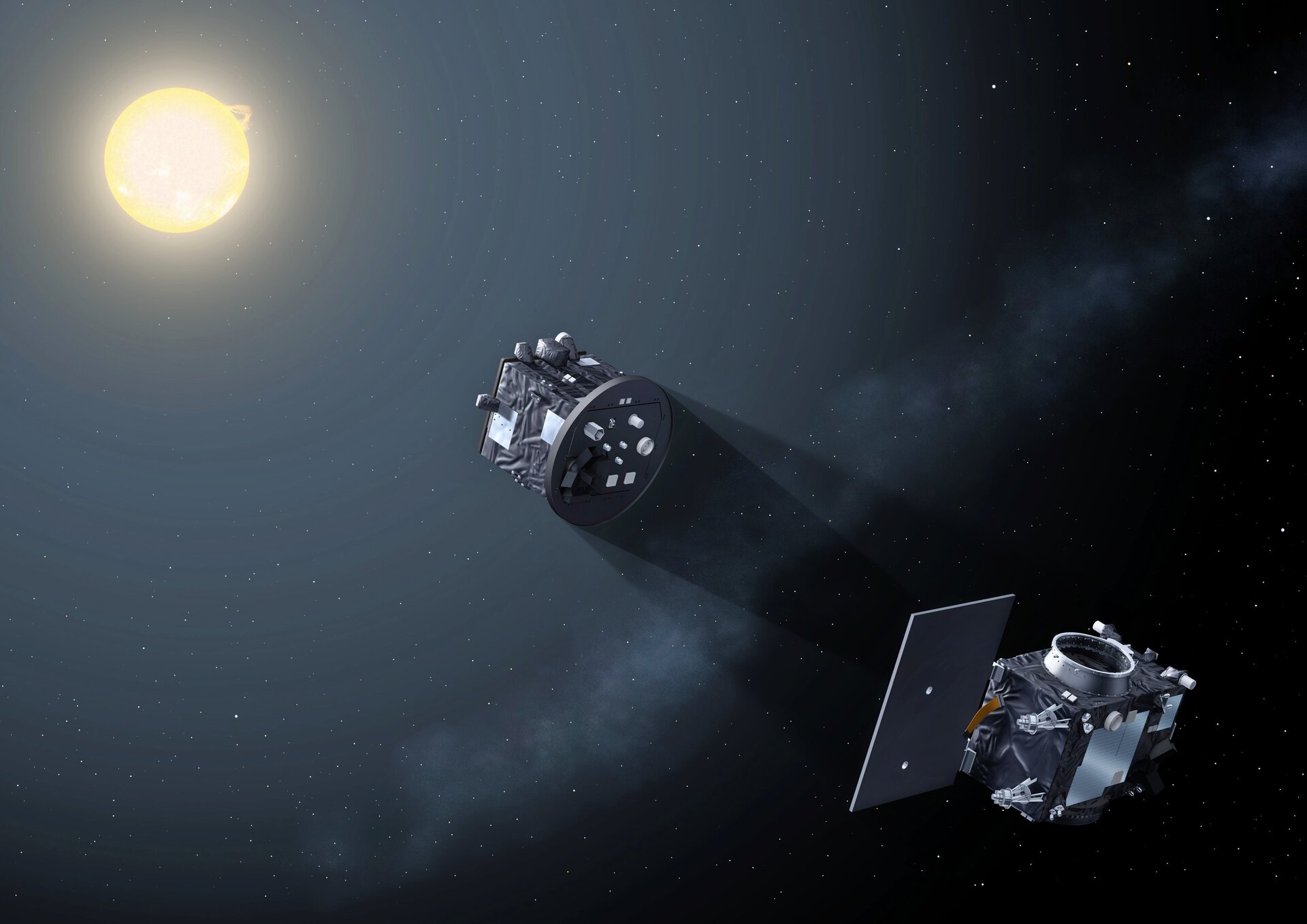


Following the recent Total Solar Eclipse, ISRO and ESA are partnering to launch Proba-3 spacecraft, which will use precision formation flying to artificially create solar eclipses in space. This innovative mission will allow for closer study of the Sun's mysterious corona and provide valuable insights into space weather. With cutting-edge technologies and precise coordination, Proba-3 is set to launch via the PSLV from India's Satish Dhawan Space Centre. Once in orbit, the spacecraft will autonomously perform formation flying, enabling six hours of observation per orbit and bridging the observational gap between the low and high corona.
Proba-3 Mission: Unveiling the Secrets of the Sun with Artificial Solar Eclipses
Following the spectacular Total Solar Eclipse in October 2023, the Indian Space Research Organization (ISRO) and the European Space Agency (ESA) are embarking on a groundbreaking mission to launch the Proba-3 spacecraft. This innovative mission will harness precision formation flying technology to create artificial solar eclipses in space, offering scientists unprecedented opportunities to study the Sun's enigmatic corona.
Background: The Importance of Studying the Corona
The corona is the outermost layer of the Sun's atmosphere, extending millions of kilometers into space. It plays a crucial role in space weather phenomena that can impact Earth's communications, power grids, and even astronauts in space. However, the corona is notoriously difficult to observe due to the Sun's intense brightness.
Proba-3 Mission: Artificial Solar Eclipses
The Proba-3 spacecraft will be launched into an elliptical orbit around Earth. Once in orbit, it will autonomously perform a complex formation flying maneuver with two separate instruments: Coronagraph 1 and Coronagraph 2.
By positioning Coronagraph 1 slightly ahead of the Sun and Coronagraph 2 precisely behind, Proba-3 will create artificial solar eclipses. During these eclipses, Coronagraph 1 will block the Sun's direct light, allowing Coronagraph 2 to capture detailed images of the corona.
Scientific Objectives
The Proba-3 mission aims to address several fundamental questions about the Sun's corona, including:
By studying the corona in unprecedented detail, Proba-3 will provide valuable insights into these phenomena and improve our understanding of space weather.
Launch and Timeline
The Proba-3 spacecraft is scheduled to launch in 2024 via the PSLV rocket from India's Satish Dhawan Space Centre. Once in orbit, it will begin its formation flying operations, enabling up to six hours of coronal observations per orbit. The mission is expected to have a lifespan of at least two years.
Top 5 FAQs
What is the purpose of creating artificial solar eclipses?
How long does each artificial eclipse last?
What instruments are used on Proba-3?
When is the Proba-3 mission expected to launch?
What is the scientific significance of the Proba-3 mission?

A college student shares her personal journey of becoming a vegetarian, despite facing challenges and health concerns. She then delves into an ethics class she took, where the concept of marginal cases were discussed. Following an article by philosophy professor Alastair Norcross, she concludes that even though individual action may seem insignificant, refusing to consume factory-farmed meat holds moral significance due to the potential to prevent immense suffering for animals.

On October 24, the global community commemorates World Polio Day to honor the legacy of Dr. Jonas Salk and the efforts of countless individuals and organizations in the fight against polio. This highly contagious and potentially deadly disease, once a widespread epidemic, is now largely preventable thanks to the development of a life-saving vaccine. India's successful eradication of polio serves as a testament to the importance of strong vaccination programs and collaborations in public health initiatives.

As winter arrives in India, so does the hazardous air pollution. Delhi NCR's AQI has already crossed the 400 mark, making it crucial to invest in air purifiers, especially after Diwali. Dyson, Qubo, HomePure, and Philips have launched high-quality air purifiers with advanced features to tackle different types of pollutants and create cleaner indoor air. With prices ranging from Rs 5,000 to Rs 1 lakh, these purifiers are a practical and timely purchase for a healthier living.

In a recent family vlog, Indian celebrity couple Shoaib Ibrahim and Dipika Kakar shared their "natural" hair care routine for their son, using a homemade mask made with rice flour, flax seeds, and coconut oil. However, experts warn that what works for adults may not be suitable for babies, whose sensitive skin and scalp could react to the ingredients. While the ingredients may improve hair texture, they do not necessarily promote hair growth. Instead, a healthy diet and good scalp care are more important in maintaining healthy hair.

A recent consumer study has found multiple brands of soft contact lenses in the U.S. to contain "forever chemicals" that can be harmful to both the body and the environment. The study, conducted by the nonprofit organization Environmental Health Sciences, tested 18 varieties of popular contact lenses and found all of them to contain markers for PFAS. Brands such as Acuvue, Alcon, and CooperVision were among the list of affected products. This news serves as a cautionary lesson on the potential risks of overusing contact lenses.

On the birth anniversary of Dr. APJ Abdul Kalam, the ‘Missile Man’ of India, tributes pour in on social media celebrating his life, vision and impact. A visionary scientist, inspiring leader and true patriot, Dr. Kalam's humility, compassion and constant interaction with students continue to inspire generations. His tireless efforts in defense, science and youth empowerment have strengthened India's path towards self-reliance and his legacy continues to motivate young minds to dream big and work hard for the nation.

Recent studies have found that extreme heat, particularly when combined with high humidity, can have a significant impact on mental health. A study in India showed that when wet bulb temperature exceeded 27°C, the probability of reporting severe depression increased by 0.5%, even when the temperature was slightly lower. This finding is consistent with global reviews that have linked high temperatures to mood disorders, increased hospital admissions for psychiatric conditions, and even elevated suicide risk. The Lancet has also published evidence that rising temperatures worldwide are a growing threat to emotional and cognitive health.

In a meeting with university officials in Udaipur, Rajasthan Governor Hari Bhau Bagde stressed the importance of incorporating India's ancient knowledge traditions into academic research. He highlighted the deep repository of knowledge in India since ancient times and urged scholars and scientists to draw upon this tradition in their work. Bagde also suggested making ancient texts available in university libraries for study and research purposes, in order to shape the intellectual abilities and love for the nation among the younger generation.

John Clarke, Michel H. Devoret, and John M. Martinis have been awarded the 2025 Nobel Prize in Physics for their pioneering research into quantum mechanical tunnelling. Their discovery has opened new possibilities for quantum technologies, and will be formally presented on December 10, the anniversary of Alfred Nobel's death. This announcement follows the tradition of recognizing transformative contributions to science, and the award carries a prestigious prize of 11 million Swedish kronor.

The US-Japanese trio of Mary E Brunkow, Fred Ramsdell, and Shimon Sakaguchi have won the 2025 Nobel Prize in physiology or medicine “for their discoveries concerning peripheral immune tolerance". Through their research, they have shown how the immune system is kept in check and why serious autoimmune diseases do not affect everyone. Sakaguchi found a new class of T cells, while Brunkow and Ramsdell discovered the explanation behind a specific mouse strain's vulnerability to autoimmune diseases. Together, they have significantly advanced our understanding of immunology and autoimmune diseases.